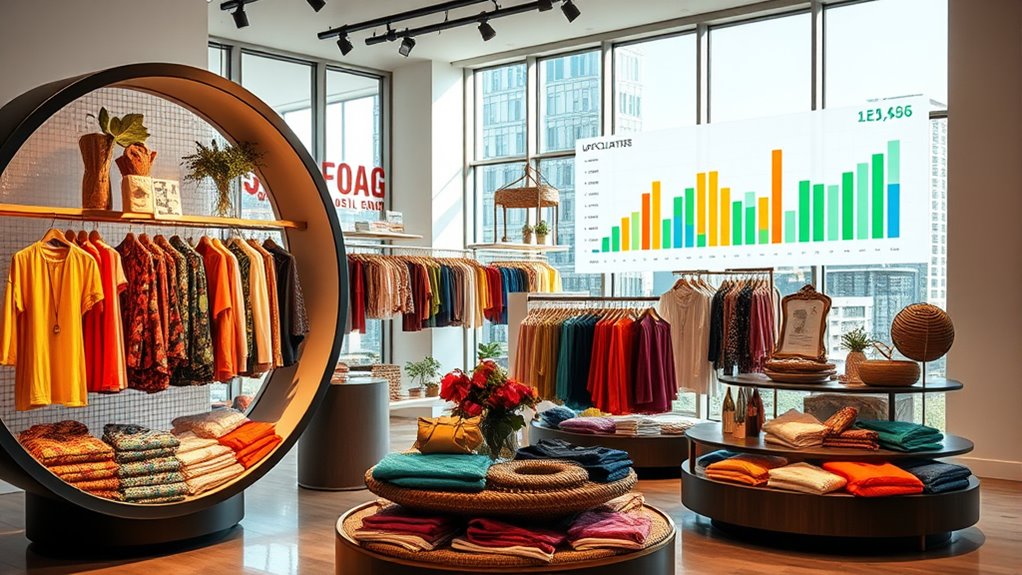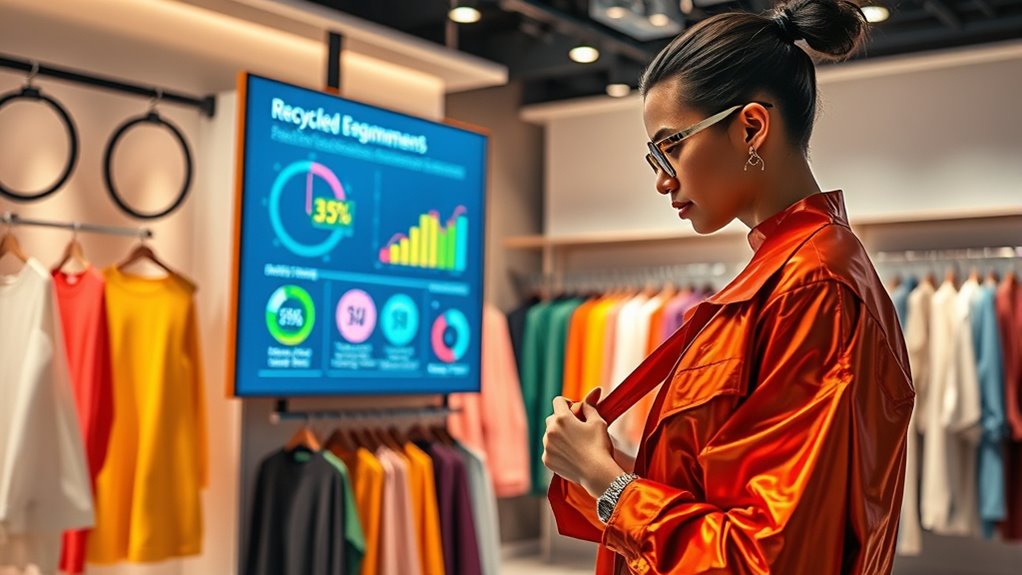Yes, circular fashion can be profitable, and the numbers support this. By integrating circular principles, you can cut operational costs, create new revenue streams from resale and leasing, and boost customer loyalty through eco-friendly practices. Consumer willingness to pay premiums for sustainable products further enhances profitability. Additionally, sustainable supply chains reduce raw material costs and minimize waste. If you want to discover how these strategies can benefit you, there’s more to explore below.
Key Takeaways
- Circular fashion reduces operational costs through resource reuse, recycling, and waste minimization, enhancing profit margins.
- Resale platforms and leasing programs generate new revenue streams, boosting profitability.
- Eco-conscious practices increase brand loyalty and consumer willingness to pay premium prices.
- Sustainable supply chains stabilize costs and mitigate raw material price volatility.
- Growing investor interest and consumer demand for eco-friendly products drive long-term financial growth.

Have you ever wondered if circular fashion can be truly profitable? It’s a question that often lingers as brands and consumers alike seek more sustainable options. The good news is, the numbers increasingly support the idea that circular fashion isn’t just environmentally responsible—it’s financially viable. As the industry shifts toward more sustainable supply chains, companies are finding that integrating circular principles can reduce costs, open new revenue streams, and boost brand loyalty. This shift isn’t just a moral choice; it’s a strategic move driven by noticeable consumer behavior shifts. More consumers are demanding eco-friendly products, willing to pay premiums for brands that demonstrate environmental responsibility. This change in consumer preferences creates a fertile ground for circular models to thrive economically.
The shift toward sustainable supply chains is a critical factor in this profitability. Circular fashion encourages the reuse, recycling, and refurbishing of garments, which cuts down on raw material costs and minimizes waste. When brands establish closed-loop systems—where products are designed to be easily recycled or repurposed—they reduce dependency on finite resources. This not only lowers material costs but also safeguards against volatile raw material prices, making supply chains more predictable and resilient. As a result, businesses can operate more efficiently and with greater certainty about their expenses, which positively impacts profit margins. Incorporating knowledge about expiration and spoilage can help brands better manage inventory and reduce waste, further enhancing profitability. Additionally, applying supply chain management principles can optimize resource use and streamline operations, increasing overall efficiency. Furthermore, understanding the safety features of materials and products ensures compliance and reduces potential liabilities, contributing to long-term sustainability. Recognizing the importance of material durability can also extend product lifecycle and enhance consumer trust. Emphasizing product lifecycle management can help brands develop strategies to maximize the use and reuse of their products, ultimately driving profitability.
Consumer behavior shifts play a crucial role here too. Today’s shoppers are more conscious about their impact on the environment and are actively seeking out brands that align with their values. They’re willing to invest in durable, high-quality pieces that can be reused or traded, rather than constantly buying new. This shift encourages brands to adopt circular practices because it enhances customer loyalty and creates opportunities for innovative business models, like resale platforms or garment leasing programs. These initiatives generate additional revenue streams that were traditionally unavailable in linear supply chains. Plus, the branding benefits of being seen as eco-conscious appeal to a broader audience, boosting sales and market share.
Furthermore, studies show that companies embracing circular principles often experience cost savings over time. For instance, reducing waste disposal costs and reusing materials can significantly improve profit margins. Some brands even find that their circular efforts attract investors interested in sustainable practices, adding another layer of financial incentive. As consumer demand for sustainable products continues to grow, and as companies refine their supply chains to be greener and more efficient, the profitability of circular fashion becomes clearer and more attainable. The numbers demonstrate that this isn’t just a trend—it’s a smart, profitable evolution for the fashion industry.
Frequently Asked Questions
How Do Circular Fashion Startups Secure Initial Funding?
To secure initial funding, you should emphasize your circular fashion startup’s focus on sustainable supply chains and eco-friendly practices. Highlighting your innovative approach and potential for growth attracts investor interest. You can also showcase market research and projections to demonstrate demand. Building a compelling pitch that aligns with investor values around sustainability and profitability increases your chances of gaining the necessary funds to kickstart your business.
What Are the Main Challenges in Scaling Circular Fashion Models?
You face challenges like managing complex supply chains and ensuring consumer education when scaling circular fashion models. The supply chain must adapt to new practices, materials, and logistics, which can be costly and time-consuming. Meanwhile, educating consumers about the value of circular products is vital for demand growth. Overcoming these hurdles requires strategic planning, innovation, and clear communication to build trust and expand your sustainable fashion footprint.
How Does Consumer Behavior Impact Circular Fashion Profitability?
You’re right to contemplate how consumer behavior impacts profitability. Sustainable consumer preferences influence your sales, as more customers seek eco-friendly options. If you encourage higher purchase frequency through incentives or quality, your circular fashion brand can thrive. By understanding and catering to these preferences, you build loyalty, increase revenue, and make circular fashion more profitable. Engaging consumers with transparent, sustainable practices ensures long-term success for your business.
Are There Regional Differences in Circular Fashion Profitability?
While circular fashion’s profitability varies, regional market dynamics and manufacturing cost variations play vital roles. You’ll find that regions with stronger consumer demand and supportive policies tend to see higher profits. Conversely, areas with higher production costs or less awareness face challenges. So, understanding local economic factors helps you navigate regional differences, making circular fashion more viable across diverse markets. Your success depends on tailoring strategies to each region’s unique landscape.
What Technological Innovations Are Driving Circular Fashion Success?
You see that technological innovations like advanced recycling technologies and sustainable materials are transforming circular fashion. These innovations enable you to recycle fabrics more efficiently and incorporate eco-friendly materials into your designs. By adopting cutting-edge recycling technologies, you reduce waste and lower costs, making your circular fashion efforts more profitable. Embracing sustainable materials also appeals to eco-conscious consumers, strengthening your brand and ensuring long-term success in the circular fashion industry.
Conclusion
Just like the phoenix rising from its ashes, circular fashion proves it can be profitable if you embrace its potential. The numbers don’t lie—you have the chance to turn sustainability into a thriving business model. By investing in circular practices, you’re not just following trends; you’re shaping the future. Remember, the road to success is paved with innovation and resilience—traits that define both profitable fashion and the enduring myth of rebirth.
Amina brings over a decade of journalism experience to her role as Editor-in-Chief. Under her leadership, Exquisite Post has flourished, maintaining the highest standards of integrity and excellence. Amina’s commitment to truth and her visionary approach guide the editorial team in producing impactful news stories that resonate with our audience.










